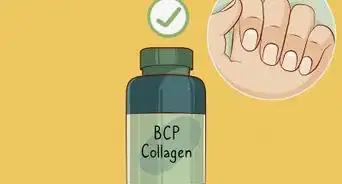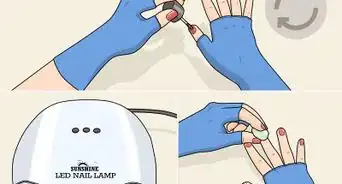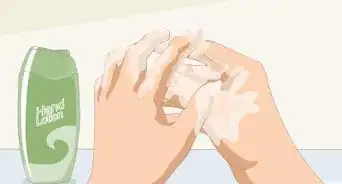This article was co-authored by Kristin Pulaski and by wikiHow staff writer, Luke Smith, MFA. Kristin Pulaski is a Professional Nail Artist and the Founder of Paintbucket, a self-owned and operated nail salon based in Williamsburg, Brooklyn. She has over five years of experience running Paintbucket and is licensed as a nail technician. Paintbucket offers nail art manicures, pedicures, and soft gel extensions along with customized packages for wedding and bridal parties. She holds a BA in Managerial Science from Manhattan College.
There are 12 references cited in this article, which can be found at the bottom of the page.
wikiHow marks an article as reader-approved once it receives enough positive feedback. This article has 26 testimonials from our readers, earning it our reader-approved status.
This article has been viewed 8,712,378 times.
Let’s get one thing out of the way: The best way to remove acrylic nails is by visiting a nail tech. That said, if you’re here, you probably can’t get into the salon for one reason or another, but those acrylic nails need to come off, STAT. And if you’re going to do it yourself, we’re going to help you do it right. We’ve put together a handy guide to removing acrylic nails with acetone, dental floss, and an electric nail filer, so you can free your fingers at home. Grab some nail clippers and a filer, because today, you’re your own nail tech.
Things You Should Know
- Clip your nails and wrap them in acetone-soaked cotton balls and tin foil. Then, wait 30 minutes before gently pulling them off.
- Loosen the base of the nail with a pick, then work a length of dental floss between the acrylic and natural nail until the acrylic nail comes free.
- Use an electric nail filer to file away the polish, color, and the acrylic nail itself. Then use a hand-filer to finish the job.
- Moisturize your nails with argan oil, cuticle cream, and moisturizer to help your nails recover from the acrylics.
Steps
Acetone
-
1Use nail clippers to trim the tips of your acrylic nails short. Cut off as much of the acrylic as you can—the more you can cut off now, the easier the rest of the process will be.[1] If cutting is difficult due to the thickness of the nails, use a coarse nail file to file them. Make sure you don't cut any of your nail bed.
-
2File the topcoat and nail polish off of your nails. Use a fine-grade buffer or a nail file to remove as much product as possible.[2] Use long strokes that run the length of the nail, and keep filing until the product is removed or the smooth, shiny layer gives way to a more matte surface.[3]
- Clipping your nails will help the acetone dissolve the acrylics more easily.
- This may take some time, depending on the size of your nails and how much product is on them, so sit tight and persevere.
- Take care not to file or damage your natural nail as you do this.
Advertisement -
3Soak 10 cotton balls in acetone. Fill a medium glass bowl halfway with acetone. Then, drop 10 cotton balls into the acetone, making sure each is completely saturated.[4]
- Acetone is highly flammable and produces potent fumes. Make sure the room is well ventilated, and keep the acetone away from heat or sources of flames.
-
4Cut out 10 squares of foil that are 5 in × 5 in (13 cm × 13 cm). While the cotton balls soak, cut out 10 squares of tinfoil. Make each square large enough to wrap completely around your finger. They don’t have to be neat![5]
-
5Apply petroleum jelly to the skin surrounding your nails. Acetone is hard on skin, so it's important to protect your fingers. Rub a generous amount of petroleum jelly on the tips of your fingers and the cuticles–even up to the first knuckle, if you’re feeling especially cautious.[6] Be careful not to apply the petroleum jelly to the nails themselves, which may hinder removal.
- Use a cotton-tipped wooden applicator if you need help applying the petroleum jelly more precisely.
-
6Secure the cotton balls to your fingers with tin foil. Place a cotton ball in the center of a tin foil square, then place the 2 together on top of a nail, with the cotton ball touching the nail. Then, wrap the tin foil around your nail to secure the cotton ball. Repeat this for each nail.[7]
- You can use a non-plastic tape to fasten the cotton balls if you don't have aluminum foil–acetone will dissolve plastic tape!
- You can also simply soak your nails in a bowl of acetone for 30 minutes if you know that acetone doesn't irritate your skin.
-
7Take the foil bundles off your nails after 30 minutes. Unwrap the tinfoil and gently but firmly pull the cotton ball and acrylic away from your natural nail. The acetone has loosened the acrylic from your nail, and the acrylic nail will come away without much fuss.[8]
- If you soaked your acrylic nails in the bowl of acetone, gently pry the nails off using an orange wood stick.
- If the acrylic nails are still firmly stuck, repeat the process and let your nails soak for another 20 minutes and attempt to remove them again.
-
8Sand off the leftover acrylic and shape your nails with the nail filer. The acrylic will be soft from the acetone bath, so take the opportunity to buff the rest of it away, until there’s no more residue left on your nails. Then, use nail clippers and a nail file to smooth the sharp edges and round out your nails. After, buff your nails lightly with a fine-grade nail buffer, moving from the base of the nail to the tip, to give them a nice, smooth sheen.[9]
- If the acrylic begins to harden again while you're buffing, use a cotton ball soaked in acetone to dampen it.
- To avoid damaging your nails, file in one direction only, and avoid using a back-and-forth sawing motion.
- The top few layers of your nails may have been removed with the acrylic. Buff and file gently so as not to tear or damage them further when file and buff them.
-
9Wash your hands and apply lotion to moisturize them. Acetone can cause skin to become extremely dry, so restore a little moisture to your fingers. Wash your hands with warm water and mild hand soap. Then, dry your hands and rub them with body oil or a moisturizing lotion. Rub the moisturizer into your nails, cuticles, and skin to keep them hydrated and to help them recover from the acrylics.[10]
Dental Floss Pick
-
1Pry up the bottom edge of an acrylic nail with a floss pick. Use a floss pick or a cuticle stick to gently lift the edge of the nail closest to your cuticle. Insert the pick between the acrylic nail and your natural nail, and loosen as much of the acrylic nail as possible.[11]
- When using this method, work slowly and carefully. Removing acrylic nails without chemical assistance (like acetone) may cause damage to your nails.
- Soak your nails in acetone using the acetone method for easier removal with dental floss.
-
2Slide the floss under the loosened edge until the nail comes off. Use the floss end of the pick, and slowly and gently move the floss back and forth in a sawing motion. As you work, apply slight pressure in the direction away from your cuticle in order to work the floss along the underside of the acrylic nail. Continue this way until the acrylic nail comes off, and repeat the process for each nail.[12]
- Use another finger to hold the base of the nail in place so that it doesn’t wiggle uncomfortably as you floss it away.
- You can also use standard floss, but you may need a partner to help you.
-
3Buff your nails and apply Argan oil to restore them. Use a buffer to clean up your natural nails and remove any acrylic residue. Then, apply Argan oil, cuticle cream, or moisturizer in order to strengthen your nails.[13]
Electric Nail Filer
-
1Clip the acrylic nails as short as possible with a nail clipper. Use the edge of the clipper to cut into the edge of the nail. Cut as close to your natural nail as possible, and then work your way across the acrylic nail until the tip of the nail is removed.[14]
- In many cases, the acrylic nail will snap off as soon as you make your first cut with the nail clipper.
-
2File away the top coat and polish with the electric filer. Set your electric nail filer to about 12,000 rpm (rotations per minute). Then, carefully lower the filing bit to the base of the nail, just below the cuticle. Graze the filer across the surface of the nail, so that a thin layer of polish, color, or whatever product is applied to the nail is sanded away. Continue to do this, following the contour of the nail.[15]
- Move the filer in one direction–towards you–as opposed to moving it back and forth across the nail.
-
3Use light, rapid back-and-forth motions to remove the acrylic. Once you’ve filed away all the product applied to the acrylic nail, begin to make swift, gentle, brushstroke-like movement across the surface of the nail to remove as much acrylic as possible. When you begin to see the natural nail beneath, reduce the filer’s rpm to about 7,000, and continue to remove as much acrylic as possible.[16]
- Once the nail is suitably thin, clip the excess acrylic off the tip of the nail.
- If at any time you become uncomfortable using the electric filer, opt to use the acetone method to soak off the rest of the nail. It’ll be much easier with much of the acrylic removed already.
-
4Use a manual filer to remove the rest of the acrylic. Once the bulk of the acrylic has been removed, set the electric filer aside, and use a hand-filer to remove the rest. Use rapid, back-and-forth movement across the entire surface of the nail, until the acrylic has been completely removed and your natural nail is entirely exposed.[17]
-
5Wash and moisturize your hands. Wash your hands with warm water and mild hand soap to remove any dust or residue. Then, dry your hands thoroughly and apply body oil, argan oil or a moisturizing lotion. Rub the moisturizer into your nails, cuticles, and skin to keep them hydrated.[18]
Expert Q&A
-
QuestionCan you use rubbing alcohol to remove acrylic nails?
 Laura MartinLaura Martin is a Licensed Cosmetologist in Georgia. She has been a hair stylist since 2007 and a cosmetology teacher since 2013.
Laura MartinLaura Martin is a Licensed Cosmetologist in Georgia. She has been a hair stylist since 2007 and a cosmetology teacher since 2013.
Licensed Cosmetologist You can; it takes longer than acetone but it will work eventually. Unfortunately, it is just as drying to the skin as acetone.
You can; it takes longer than acetone but it will work eventually. Unfortunately, it is just as drying to the skin as acetone. -
QuestionHow do you take off acrylic nails with nail polish remover?
 Laura MartinLaura Martin is a Licensed Cosmetologist in Georgia. She has been a hair stylist since 2007 and a cosmetology teacher since 2013.
Laura MartinLaura Martin is a Licensed Cosmetologist in Georgia. She has been a hair stylist since 2007 and a cosmetology teacher since 2013.
Licensed Cosmetologist Soak the nails in the remover for 10-20 minutes then gently scrape off the acrylics. You can do this by placing your fingertips in a bowl of nail polish remover containing acetone or by applying acetone-soaked cotton balls to your nails and wrapping them in foil.
Soak the nails in the remover for 10-20 minutes then gently scrape off the acrylics. You can do this by placing your fingertips in a bowl of nail polish remover containing acetone or by applying acetone-soaked cotton balls to your nails and wrapping them in foil. -
QuestionCan you use hot water to remove acrylic nails?
 Klare Heston, LCSWKlare Heston is a Licensed Independent Clinical Social Worker based in Cleveland, Ohio. With experience in academic counseling and clinical supervision, Klare received her Master of Social Work from the Virginia Commonwealth University in 1983. She also holds a 2-Year Post-Graduate Certificate from the Gestalt Institute of Cleveland, as well as certification in Family Therapy, Supervision, Mediation, and Trauma Recovery and Treatment (EMDR).
Klare Heston, LCSWKlare Heston is a Licensed Independent Clinical Social Worker based in Cleveland, Ohio. With experience in academic counseling and clinical supervision, Klare received her Master of Social Work from the Virginia Commonwealth University in 1983. She also holds a 2-Year Post-Graduate Certificate from the Gestalt Institute of Cleveland, as well as certification in Family Therapy, Supervision, Mediation, and Trauma Recovery and Treatment (EMDR).
Licensed Social Worker You can use hot water to remove acrylic nails, but it requires a long soaking time, usually about twenty minutes. Since the water is only softening the acrylic, not breaking it down, you need to wait until it has fully softened before you try to remove the nails.
You can use hot water to remove acrylic nails, but it requires a long soaking time, usually about twenty minutes. Since the water is only softening the acrylic, not breaking it down, you need to wait until it has fully softened before you try to remove the nails.
Warnings
- Acetone is extremely flammable. Keep it away from sources of heat or flame.⧼thumbs_response⧽
- If it is painful to remove the nails or if they aren’t coming off after repeated attempts, stop and consult a nail salon for help.⧼thumbs_response⧽
- An electric nail filer may cause injury if used improperly. Read the tool’s instruction manual thoroughly and familiarize yourself with its operation beforehand.⧼thumbs_response⧽
Things You'll Need
Acetone
- Nail clippers
- Nail file
- Fine-grade buffer
- Acetone nail polish remover
- Small glass bowl
- Petroleum jelly
- Aluminum foil
- Cotton balls
- Orange wood nail stick
- Moisturizer
Dental Floss
- Dental floss pick
- Nail clippers
- Nail file
- Fine-grade buffer
- Moisturizer
Electric Nail Filer
- Nail clippers
- Electric nail file
- Nail file
- Moisturizer
References
- ↑ https://www.vogue.in/how-to/content/how-to-safely-remove-your-gel-nail-polish-and-acrylic-nails-at-home
- ↑ https://www.vogue.in/how-to/content/how-to-safely-remove-your-gel-nail-polish-and-acrylic-nails-at-home
- ↑ Kristin Pulaski. Salon Owner & Nail Specialist. Expert Interview. 19 May 2020.
- ↑ https://www.elle.com/beauty/a28088918/how-to-remove-acrylic-nails/
- ↑ https://www.elle.com/beauty/a28088918/how-to-remove-acrylic-nails/
- ↑ https://www.purewow.com/beauty/how-to-remove-acrylic-nails-at-home
- ↑ Kristin Pulaski. Salon Owner & Nail Specialist. Expert Interview. 19 May 2020.
- ↑ https://www.purewow.com/beauty/how-to-remove-acrylic-nails-at-home
- ↑ https://www.vogue.co.uk/beauty/article/how-to-remove-gel-nails-at-home
- ↑ https://www.vogue.co.uk/beauty/article/how-to-remove-gel-nails-at-home
- ↑ https://www.youtube.com/watch?v=5zjGPJOMqOY&t=34s
- ↑ https://www.youtube.com/watch?v=5zjGPJOMqOY&t=68s
- ↑ https://www.youtube.com/watch?t=140&v=5zjGPJOMqOY&feature=youtu.be
- ↑ https://youtu.be/2bWPB_kUvqU?t=60
- ↑ https://www.youtube.com/watch?t=126&v=2bWPB_kUvqU&feature=youtu.be
- ↑ https://www.youtube.com/watch?t=262&v=2bWPB_kUvqU&feature=youtu.be
- ↑ https://www.youtube.com/watch?v=2bWPB_kUvqU&t=405s
- ↑ https://www.vogue.co.uk/beauty/article/how-to-remove-gel-nails-at-home
About This Article
Before you remove your acrylic nails, cut them as short as you can with nail clippers and apply petroleum jelly to the skin around your nails. Then, saturate a cotton ball with acetone and apply it to the top of each nail. Make sure the cotton ball is completely covering your nail, then wrap each finger in aluminum foil. Let dry for 30 minutes. When you remove the foil, your acrylic nails should come right off! For help dealing with particularly stubborn nails, read the article!





















































